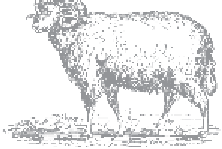Agriculture Reference
In-Depth Information
13
Records and
THE TIMES HAVE CHANGED. When Ken and I fi rst started raising
livestock, all our records consisted of notes jotted onto a calendar and into
a three-ring binder. Today our records are kept on computers. Both systems
worked, but there is no doubt that we are able to capture more information,
and more meaningful information, on the computer. No matter how you
keep records, they are important. Your records will help you make culling
and breeding decisions. They can be a valuable tool if you market breeding
stock. And they can serve as a history of your fl ock.
Record keeping starts with individual animal identifi cation. A simple
record would include a name or identifying number, the birth date or acqui-
sition date if the stock was purchased from another farm, sex, type of birth
(single, twins, triplets), and general husbandry records (such as information
on vaccinations). The next step is to capture more-detailed breeding infor-
mation, such as information on the animal's dam and sire. To improve man-
agement you can add more-detailed data on performance, such as individual
weaning weights of lambs born to a ewe or out of a ram's “get” (offspring), as
well as postweaning growth measures, such as 120-day weight.
Many purebred sheep breeders participate in the National Sheep Improvement
Program (NSIP). NSIP, which is designed to help purebred sheep producers
identify the best genetic stock for their breeding program, uses computerized,
391

